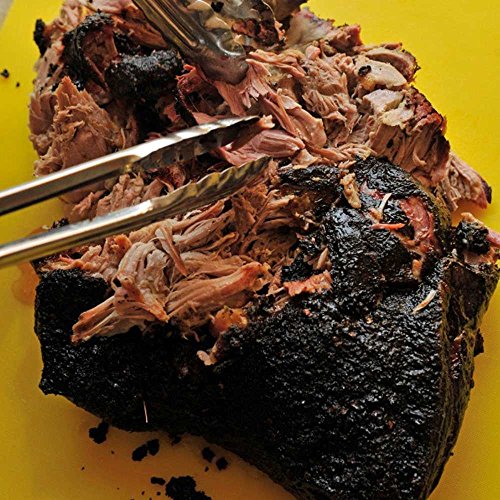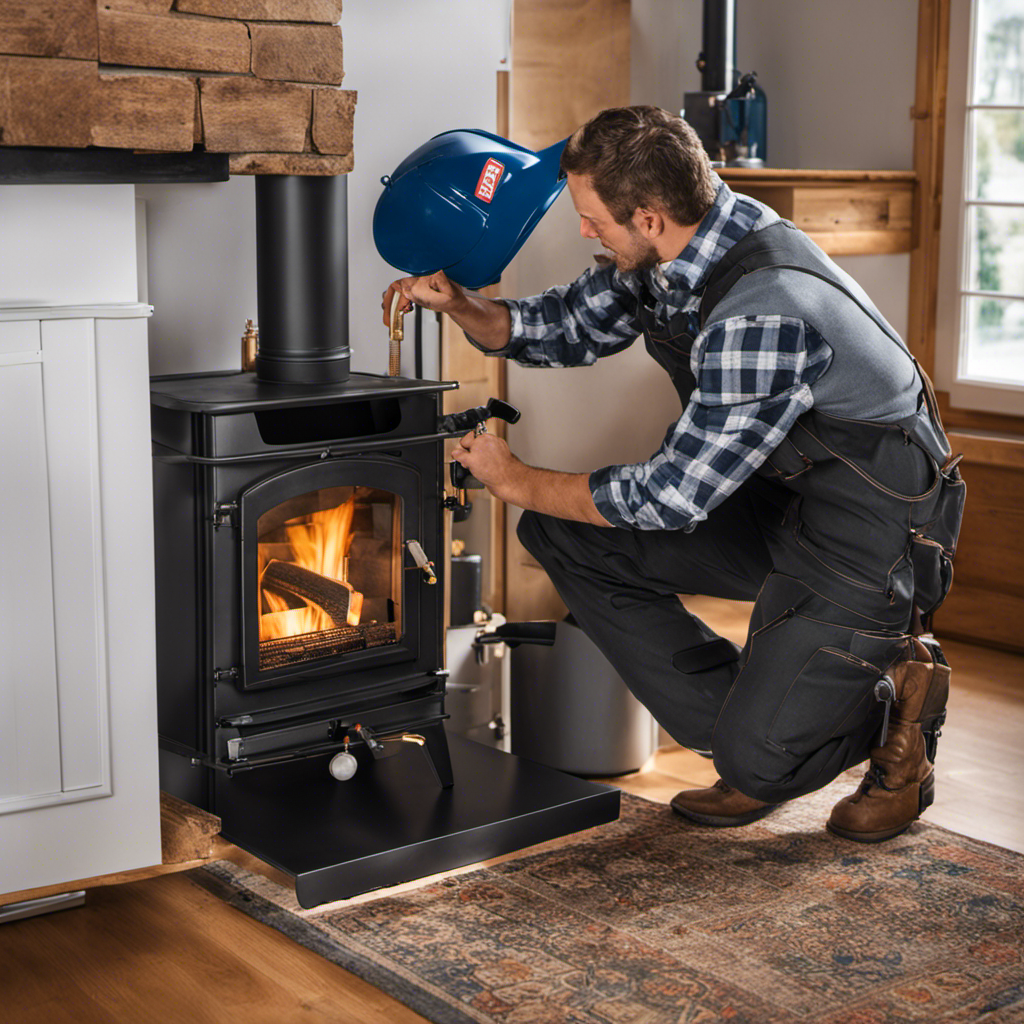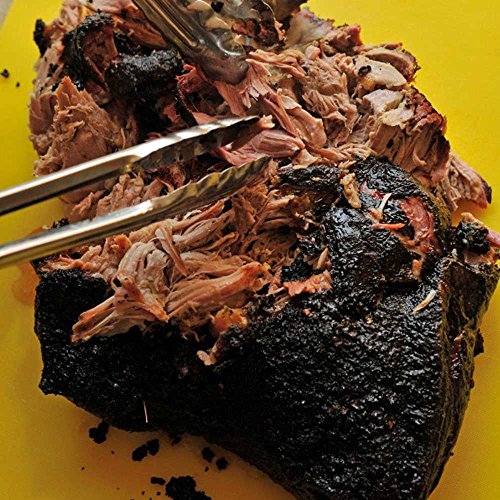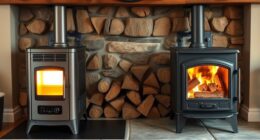Are you interested in discovering the techniques to masterfully smoke a Boston Butt using a wood pellet grill? I assure you, it’s a culinary skill that will leave your palate craving for more.
With the right wood pellet flavor and the perfect temperature, you can achieve tender, juicy meat that is bursting with smoky goodness. Trust me, once you try this technique, there’s no going back.
Get ready to become the master of the grill and impress your friends and family with the best smoked Boston Butt they’ve ever tasted.
Key Takeaways
- The choice of wood pellet flavor should be based on the type of meat being smoked.
- Trim excess fat and apply a dry rub to prepare the Boston Butt for smoking.
- Properly set up the wood pellet grill and maintain a consistent temperature for optimal smoking.
- Avoid temperature fluctuations by ensuring proper sealing, minimizing lid opening, and adjusting fuel source or airflow vents if needed.
Selecting the Right Wood Pellet Flavor
When selecting the right wood pellet flavor, it’s important to consider the type of meat you’re smoking. Different types of wood pellets impart distinct flavors that can enhance the taste of your smoked dishes. Choosing the right wood pellet flavor is crucial in achieving a delicious and well-balanced outcome.
For a boston butt, I recommend using hickory or apple wood pellets. Hickory provides a strong, smoky flavor that complements the rich and fatty nature of the pork butt. On the other hand, apple wood pellets offer a milder and slightly sweet taste, which pairs well with pork’s natural sweetness. Both options will enhance the flavor of your boston butt and create an unforgettable smoky aroma.
Now that we’ve discussed choosing the right wood pellet flavor, let’s move on to preparing the boston butt for smoking by marinating it overnight to infuse it with even more flavor.
Preparing the Boston Butt for Smoking
When it comes to preparing a Boston Butt for smoking, there are a few key steps that can make all the difference in the final result.
First, trimming excess fat is important to ensure even cooking and prevent flare-ups.
Next, applying a dry rub adds flavor and helps create a delicious crust on the meat.
Lastly, letting the Boston Butt marinate allows the flavors to penetrate and tenderize the meat for an incredibly juicy and flavorful end product.
Trimming Excess Fat
To achieve a leaner cut of meat, you can start by trimming excess fat from the Boston butt before smoking it on the wood pellet grill. This step is crucial in reducing the fat content of the meat, resulting in a healthier and more flavorful final product.
By removing any visible fat, you not only improve the nutritional profile of the dish but also enhance its flavor profile. Fat tends to mask the natural flavors of the meat, so trimming it allows other seasonings and spices to shine through during the smoking process.
Once you have completed this important task, you can move on to applying a delicious dry rub that will further enhance the taste and aroma of your smoked Boston butt.
Applying Dry Rub
After trimming excess fat, you can easily enhance the flavor of your meat by applying a delicious dry rub. Dry rub techniques are a great way to add layers of flavor and create a crust on the outside of your meat.
To start, choose a combination of spices that complement the type of meat you’re cooking. Common ingredients include salt, pepper, paprika, garlic powder, and brown sugar. Mix these together in a bowl and generously apply it all over your meat, making sure to coat every inch. The dry rub will help seal in moisture while adding depth and complexity to the taste.
Once applied, let it marinate for at least an hour or overnight in the refrigerator before smoking for optimal flavor penetration without compromising texture.
Transitioning into the subsequent section about letting it marinate without using ‘step,’ now that we have our dry rub applied, it’s time to let those flavors meld together by allowing the meat to marinate.
Letting It Marinate
Now that you’ve applied the dry rub, it’s time to let your meat marinate and allow those flavors to come together. Marinating is a crucial step in the smoking process as it helps tenderize the meat and infuse it with delicious flavors.
There are various marinating techniques you can use, such as using a marinade or simply letting the meat sit in the dry rub for several hours or overnight. The marinating time depends on personal preference and the cut of meat you’re using. Generally, allowing your meat to marinate for at least 4-6 hours will enhance its taste and tenderness.
As the flavors meld together during this time, get ready to set up your wood pellet grill for smoking by following these simple steps…
Setting Up the Wood Pellet Grill for Smoking
First, make sure you’ve filled the hopper with wood pellets and turned on the grill. Setting up a wood pellet grill for smoking is crucial to achieving that perfect smoky flavor in your Boston butt.
Start by preheating the grill to your desired temperature, typically around 225°F to 250°F. This low and slow cooking method ensures tender and juicy meat.
Place a drip pan under the grates to catch any drippings and prevent flare-ups. It’s important to avoid common mistakes like overfilling the hopper or not properly cleaning the grill before use.
Additionally, ensure proper ventilation by keeping all vents open during smoking.
Now that we have our grill set up, let’s move on to smoking the Boston butt at the right temperature.
Smoking the Boston Butt at the Right Temperature
When it comes to smoking a Boston Butt, achieving the optimal smoking temperature is crucial for a delicious and tender result. Maintaining a consistent temperature throughout the smoking process can be challenging but with the right tips, it can be achieved.
In this discussion, I will share insights on finding the optimal smoking temperatures, providing temperature control tips, and avoiding fluctuations to ensure that your Boston Butt turns out perfect every time.
Optimal Smoking Temperatures
To achieve the best results, you’ll want to monitor your wood pellet grill’s temperature throughout the smoking process. Maintaining even heat is crucial for ensuring that your Boston butt turns out tender and flavorful.
One of the benefits of low and slow cooking is that it allows the collagen in the meat to break down slowly, resulting in a juicy and succulent final product. The ideal temperature range for smoking a Boston butt is between 225°F and 250°F. This ensures that the meat cooks slowly and evenly, allowing ample time for smoke flavor to infuse into every bite.
Temperature Control Tips
For optimal temperature control, you’ll want to regularly check and adjust the settings on your grill. Temperature control techniques are crucial for achieving that perfect smoke on your Boston butt. One important technique is to preheat your grill before adding the meat. This ensures a stable starting temperature. Additionally, using a reliable thermometer will help you accurately monitor the internal temperature of the meat throughout the smoking process.
Troubleshooting temperature fluctuations can be frustrating but there are steps you can take to minimize them. First, make sure your grill is properly sealed to prevent heat from escaping. Next, avoid constantly opening the lid as this can cause significant drops in temperature. If you notice consistent fluctuations, consider adjusting the fuel source or airflow vents.
Avoiding Temperature Fluctuations
Minimizing temperature fluctuations is key to achieving consistent and delicious results while smoking your meat. Here are four essential tips to help you prevent drying out your meat and maintain a consistent smoke flavor:
-
Use quality insulation: Invest in a well-insulated smoker or grill that can retain heat efficiently. This will help minimize temperature swings caused by external factors like wind.
-
Preheat your smoker: Before adding your meat, preheat the smoker to the desired temperature. This ensures that the cooking environment is stable from the start, reducing the chances of sudden fluctuations.
-
Avoid excessive lid opening: Every time you open the lid, heat escapes, causing temperature fluctuations. Limit unnecessary peeking and only open when necessary for basting or checking doneness.
-
Monitor airflow: Proper airflow is crucial for maintaining consistent temperatures and smoke levels. Adjust air vents as needed to regulate oxygen flow and control the fire’s intensity.
By following these tips, you’ll be able to minimize temperature fluctuations, preventing drying out of your meat while maintaining a mouthwatering smoke flavor throughout the smoking process.
Now let’s move on to monitoring and maintaining the smoke levels without missing a beat.
Monitoring and Maintaining the Smoke Levels
Keep an eye on the smoke levels to ensure you’re getting that perfect smoky flavor in your Boston butt. Maintaining consistent smoke flavor is crucial for a delicious result.
To achieve this, start by ensuring that your wood pellets are producing enough smoke. If you notice the smoke starting to thin out or disappear, it might be due to insufficient airflow or a clogged heat diffuser plate. Troubleshooting these issues can help maintain the desired smoke levels throughout the cooking process.
Additionally, adjusting the temperature settings on your wood pellet grill can also impact the amount of smoke produced. By finding the right balance between temperature and smoke production, you can create a mouthwatering smoky flavor that will enhance your Boston butt’s taste and tenderness.
Now that you’ve mastered monitoring and maintaining the smoke levels, let’s move on to wrapping and resting the smoked Boston butt without compromising its juiciness and flavor.
Wrapping and Resting the Smoked Boston Butt
Once you’ve achieved that perfect smoky flavor, it’s time to wrap and let the smoked Boston butt rest for optimal juiciness and flavor.
Wrapping the boston butt during the smoking process offers several benefits. First, it helps retain moisture by trapping in the natural juices, preventing them from evaporating. Second, it allows the meat to continue cooking slowly and evenly while tenderizing further. And third, wrapping creates a barrier that prevents excessive smoke from overpowering the meat.
To achieve the perfect resting time for your smoked boston butt, follow these tips:
1) Let it rest for at least 30 minutes to allow the juices to redistribute throughout the meat.
2) Keep it wrapped tightly in foil or butcher paper to retain heat and moisture.
3) Aim for a resting temperature of around 160°F (71°C). This will ensure that your boston butt is tender and juicy when served.
After giving your smoked boston butt ample time to rest, you are now ready to serve and enjoy its perfectly smoky goodness.
Serving and Enjoying the Perfectly Smoked Boston Butt
After giving your smoked Boston butt ample time to rest, you’re now ready to slice it and savor the delicious smoky flavor.
Serving suggestions for this mouthwatering dish are endless, but here are a few ideas to get you started.
For a classic Southern-style meal, serve the sliced Boston butt on a buttered bun with coleslaw and pickles on the side. The combination of tender meat, crunchy slaw, and tangy pickles is simply irresistible.
If you’re looking for something lighter, try serving it with a fresh salad or roasted vegetables. The smoky flavors of the meat will pair beautifully with the freshness of the greens or the natural sweetness of roasted veggies.
And don’t forget about the sauces! Barbecue sauce, hot sauce, or even a homemade aioli can take your Boston butt to new heights of deliciousness.
So go ahead and enjoy every bite of your perfectly smoked creation!
Frequently Asked Questions
How Long Does It Take to Smoke a Boston Butt on a Wood Pellet Grill?
It takes several hours to smoke a Boston Butt on a wood pellet grill. Achieving a perfectly smoky flavor requires patience and attention to temperature and seasoning.
Can I Use Any Type of Wood Pellets for Smoking a Boston Butt?
Can I use any type of wood pellets for smoking a Boston Butt? Different types of wood pellets can add unique flavors to the meat. However, the best wood pellets for smoking a Boston Butt are typically hardwood varieties like hickory or oak.
Do I Need to Marinate or Season the Boston Butt Before Smoking It?
I prefer to season my Boston butt before smoking it rather than marinating. Seasoning allows the flavors to penetrate the meat better and creates a delicious bark. I recommend using a rub with salt, pepper, paprika, garlic powder, and brown sugar.
Can I Smoke a Frozen Boston Butt on a Wood Pellet Grill?
Smoking a frozen Boston butt on a wood pellet grill offers several benefits. The low and slow cooking process allows for tender and flavorful meat, while the frozen state helps retain moisture.
Can I Smoke Other Meats Alongside the Boston Butt on the Wood Pellet Grill?
Yes, you can smoke multiple meats alongside the Boston Butt on a wood pellet grill. Here are some tips for smoking on a wood pellet grill: maintain a consistent temperature, use appropriate seasoning, and allow enough time for the meat to cook thoroughly.
Conclusion
So there you have it, the step-by-step guide on how to smoke a Boston Butt on a wood pellet grill.
I have shared my knowledge and experience with you in order to help you achieve the perfect smoked Boston Butt.
By following these instructions and using the right wood pellet flavor, preparing the meat properly, and maintaining the right temperature and smoke levels, you can create a mouthwatering masterpiece that will impress your friends and family.
So go ahead, fire up that wood pellet grill and get ready for some amazing flavors!
Growing up surrounded by the vast beauty of nature, Sierra was always drawn to the call of the wild. While others sought the comfort of the familiar, she ventured out, embracing the unpredictable and finding stories in the heartbeat of nature.
At the epicenter of every remarkable venture lies a dynamic team—a fusion of diverse talents, visions, and passions. The essence of Best Small Wood Stoves is crafted and refined by such a trio: Sierra, Logan, and Terra. Their collective expertise has transformed the platform into a leading authority on small wood stoves, radiating warmth and knowledge in equal measure.












